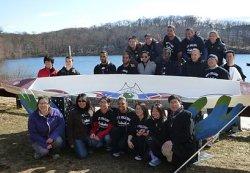
City College Concrete Canoe Team and its 1st place winning canoe, Diversitas. (Credit: Weihua Jin)
A team of City College of New York engineering students paddled their way to victory in a “green” concrete canoe they designed and built for the 2011 Metropolitan Region Concrete Canoe Competition held last month in Denville, N.J.
“This is a wonderful project in which we train students to know not just the formulas, but to understand design and construction in the real world,” says Dr. Weihua Jin, City College substitute associate professor of civil engineering and team advisor. The competition, organized by the American Society of Civil Engineers (ASCE) and held in conjunction with its regional student conferences, promotes mastery of engineering skills outside of the classroom.
Surprisingly glossy and seaworthy for a boat essentially cast in stone, the “Diversitas” placed first in both the men’s and women’s sprint competitions. The team also captured first place in the earlier display portion of the competition, which featured the team’s engineering book, a poster, a cross section of the craft, materials samples and the canoe itself.
Their combined wins allowed the team to prevail overall against five other regional teams in a competition that also included a technical paper, a presentation and a “swamp test” to measure buoyancy.
The students dubbed their craft “Diversitas” and adorned it with a design of interwoven flags to reflect the diversity of City College and the team itself. Members claim origins of/from 15 different countries, including the Dominican Republic, Mexico, Albania, China, and Korea.
The students’ canoes must meet very precise dimension specifications set out by the ASCE. They also must be strong enough to carry the weight of passengers without cracking, yet float when filled with water. CCNY’s winning entry measured 20 feet long and weighed in at only 230 pounds, nearly a third the weight of another team’s entry.
The team’s secret is a concrete formula that incorporates glass from recycled bottles, making the material lighter and shrinking its carbon footprint. Professor Jin, a 25-year veteran of the concrete industry, came up with the original version of the formula years ago.
“Much of it is from my own research incorporating recycled bottles, not just for the sake of using recycled glass, but for its strength and beauty. If you do it the wrong way, though, it actually weakens the concrete,” said Professor Jin. Improperly mixed concrete can crack or break, as did the canoes of some other teams at the competition.
Each year, his students improve upon the formula, which incorporates an aggregate of crushed glass bottles instead of gravel or sand to fill air pockets. Powdered glass also serves as the “cementatious” material, which reacts with cement to strengthen its binding properties.
One ton of standard cement releases one ton of carbon dioxide, but by replacing some of the cement with glass, one can reduce the carbon footprint without reducing the amount of cement. “This is really the best canoe they’ve ever made; the greenest and the most beautiful,” said Professor Jin.
In fact, Professor Jin has had a significant influence on the rules of the competition itself. His was the first team to enter a “green” canoe using sustainable materials several years ago when he advised another team.
“I see it as an opportunity to educate my students in my interest in sustainable materials,” he noted. The team won and the judges were so impressed with the showing that they made sustainability a requirement from then on.
The competition requires building skills in design, construction, sportsmanship, analysis, coordination, management and use of green materials, Professor Jin pointed out. “This is something you cannot learn from a textbook, but it is something that future employers are looking for.”
Teams compete for a total of 100 points with a maximum of 25 points each awarded for a technical paper, oral presentation, the display and the five races. Construction itself involves at least 100-person-hours during a semester, concentrated toward the end, during which students design the mixture, test the concrete and, finally, cast the canoe in a single day.
“Definitely one of the best things I’ve gotten out of it are the friendships I’ve made,” said three-time team captain and junior civil engineering major Francisco Amarante. He has also enjoyed being an active member of a paddling club in Queens over the past few years, to augment his skills outside of school.
The Concrete Canoe Club gives hands-on engineering experience invaluable for the future job search, he noted, as well as practice in the writing of technical papers and working with a team of people who have different skills. “And then you bring it all together to make something great.”
On the web:
2011 Diversitas Win Pictures
https://picasaweb.google.com/107399061711392472713/2011CanoeCompetition…
ASCE National Concrete Canoe Competition
http://content.asce.org/conferences/nccc2011/index.html
Unofficial Concrete Canoe Competition site
http://www.concretecanoe.org/
MEDIA CONTACT
Jessa Netting
p: 212.650.5310